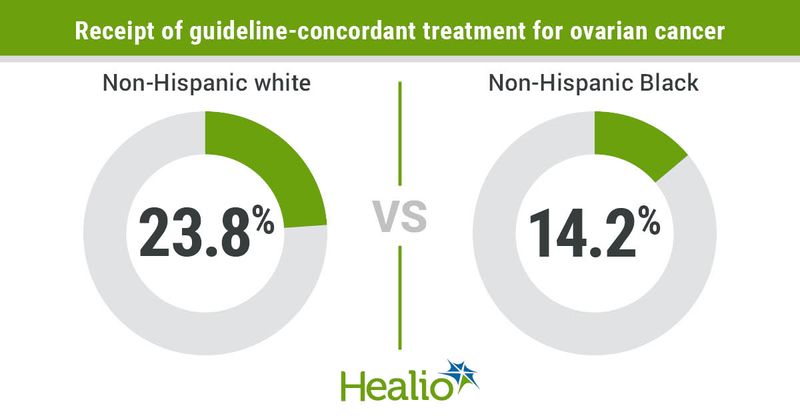Black women less likely to receive guideline-concordant therapy for ovarian cancer
Black women in the U.S. appeared less likely than white women to receive guideline-concordant treatment for ovarian cancer, according to a study published in Journal of the National Comprehensive Cancer Network.
Even among white women, the vast majority — more than 75% — did not receive surgery and chemotherapy as recommended by National Comprehensive Cancer Network guidelines for ovarian cancer, researchers wrote.

Background
Ovarian cancer is the fifth leading cause of cancer-related death and the deadliest gynecologic malignancy in the U.S.
Prior studies examined the association between receipt of guideline-concordant care and five individual dimensions of health care access — affordability, availability, accessibility, accommodation and acceptability. However, no studies comprehensively evaluated various dimensions simultaneously among a diverse group of women with ovarian cancer, according to study background.
NCCN guidelines for ovarian cancer recommend surgical staging and cytoreduction plus systemic chemotherapy. Maximal cytoreductive surgery correlates with longer survival, while the lack of guideline-concordant treatment is an independent predictor of shorter survival, researchers wrote.

“Despite much progress in ovarian cancer therapy, many women fail to benefit due to lack of access,” Tomi F. Akinyemiju, PhD, vice chair for diversity and inclusion at Duke University’s department of population health sciences and associate director for community outreach, engagement and equity at Duke Cancer Institute, told Healio. “As we continue to develop groundbreaking therapies that can help [people with cancer] live longer and healthier lives, we must also ensure that those therapies benefit the patients [who] need it most.”
Methodology
Akinyemiju and colleagues used the SEER-Medicare database to conduct an observational cohort study that evaluated the association between health care access dimensions and receipt of guideline-concordant treatment for ovarian cancer.
The analysis included 5,632 women (88% non-Hispanic white, 6% non-Hispanic Black, 6% Hispanic) who had at least 12 months of continuous Medicare fee-for-service coverage before and after ovarian cancer diagnosis.
All women were aged 65 years or older and had been diagnosed with primary ovarian cancer between 2008 and 2015. Investigators excluded women with fallopian tube cancer, borderline tumors or peritoneal cancers, as well as those who died of ovarian cancer in the first year after diagnosis to allow for evaluation of receipt of treatment.
Results
A higher percentage of non-Hispanic white women than non-Hispanic Black women received fully guideline-concordant surgery and chemotherapy (23.8% vs. 14.2%).
Racial disparities persisted after adjustments for patients’ ability to pay for care and whether they had access to local specialists.
Higher affordability (RR = 1.05; 95% CI, 1.01-1.08) and availability (RR = 1.06; 95% CI, 1.02-1.1) appeared associated with receipt of guideline-concordant surgery, whereas higher affordability appeared associated with initiation of systemic therapy (HR = 1.09; 95% CI, 1.05-1.13).
After adjustments for all three health care access scores, as well as demographic and clinical characteristics, non-Hispanic Black women remained less likely than non-Hispanic-white patients to initiate systemic therapy (HR = 0.86; 95% CI, 0.75-0.99).
“Cancer treatment, particularly for ovarian cancer — which is often diagnosed at late stages — is extremely complicated. In addition to the physical toll on the patient, there are also substantial financial and logistical challenges patients and their loved ones must navigate,” Akinyemiju told Healio. “For patients who are from low-income and under-served communities, this becomes almost impossible.
“The disparities observed in receipt of quality ovarian cancer in this study were partly explained by financial, distance and health care system factors,” Akinyemiju added. “However, racial differences still persisted, indicating that there are other challenges facing Black [patients with ovarian cancer] in accessing the needed care that must be investigated and addressed.”
Next steps
Additional research that examines other health care access dimensions, as well as facilitators and barriers to treatment, is necessary to increase the percentage of women with ovarian cancer who receive optimal treatment and reduce disparities, investigators concluded.
The observation that most women with ovarian cancer — regardless of race — do not receive guideline-concordant care indicates that additional efforts are needed to ensure all patients receive optimal care, Akinyemiju added.
“Lack of access to quality care is a problem for most patients with ovarian cancer,” Akinyemiju told Healio. “Although other factors like frailty, comorbidities and patient preferences may play a minor role, significant challenges at the community, health system and provider levels must be addressed. ... We must rethink our approach to cancer care and develop a safety net system that ensures access to the highest quality treatment for [people with cancer] regardless of ability to pay, location or race.”
For more information
Tomi F. Akinyemiju, PhD, can be reached at Department of Population Health Sciences, Duke University School of Medicine, 215 Morris St., Durham, NC 27708; email: tomi.akinyemiju@duke.edu.

